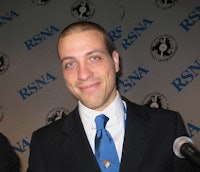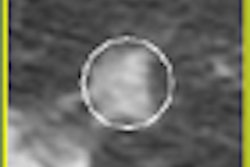
CHICAGO - An ultrasound-guided technique appears to provide long-term, near sequelae-free relief to patients suffering from chronic, debilitating plantar fasciitis, researchers reported at the 2008 RSNA annual meeting in Chicago.
With the technique, doctors locate the fascia using ultrasound and insert a needle percutaneously until it is positioned just outside the fascia. A layer of anesthetic is laid on top of the fascia, and the doctor begins puncturing the fascia in a procedure known as dry-needling because no medication is introduced into the fascia. After the dry-needling, a layer of steroids is also introduced outside the fascia.
 |
| Dr. Luca Sconfienza from the University of Genoa, Italy. |
"Our therapy is quicker, easier, less painful, and less expensive than shockwave therapy," Sconfienza said. Shockwave therapy can be painful and requires at least three hospital visits. It also tends to be ineffective in the long term, he said.
Sconfienza estimated that more than 1 million people in the U.S. -- predominantly women over the age of 50 -- experience the discomfort of plantar fasciitis, and many of them have suffered for years until the acute pain becomes chronic, resulting in loss of work and the ability to perform regular activities of daily living.
He recruited 44 individuals, 39 women and five men, to undergo a procedure in which ultrasound imaging is utilized to precisely perform the treatment.
Sconfienza said the goal of dry-needling is to cause some minor bleeding to induce recruitment of healing properties to the site, enhancing recovery from overall discomfort. The steroids are intended to control inflammation. "The dry-needling performed on plantar fascia and on periosteum produces a local hyperemia that can be compared to a surgical debridement," he explained.
He said that 39 of the patients in the study achieved complete pain relief from plantar fasciitis within two to three weeks after the treatment. In three cases, patients experienced an initial period of increased pain, which later diminished and then disappeared within the same two- to three-week period. The other two patients showed no improvement, but Sconfienza said they did not have any greater pain than before the treatment.
He said there have been no recurrences of pain among the successfully treated patients for at least six months. The needle insertion may cause a period of pain that lasts about five seconds, he said.
Dr. Philip Alderson, dean of the school of medicine at Saint Louis University, who moderated a press briefing on behalf of RSNA, noted that the study did not have a control group.
"To be scientifically valid, a controlled experiment would be nice to have so we can get an accurate idea of how well this procedure works," he said. However, he suggested that its low cost and apparent success would likely lead some clinicians to try the procedure without a validating study.
Sconfienza estimated that the treatment costs about $96. Shockwave therapy can cost more than $460, he said.
By Edward Susman
AuntMinnie.com contributing writer
December 2, 2008
Related Reading
Scintigraphy pegs potential responders to plantar fasciitis treatment, October 25, 2006
US demonstrates continuity between lesion, plantar fascia, December 17, 2002
Copyright © 2008 AuntMinnie.com

















